Probabilistic Topic Modeling with LDA¶
Python User Group Workshop¶
Markus Konrad markus.konrad@wzb.eu
January 2018
Material will be available at: http://dsspace.wzb.eu/pyug/topicmodeling1/
Next time¶
- Example: A topic model for the parlamentary debates of the 18th German Bundestag
- Data preparation
- Model selection
- Visualization and evaluation
What is Topic Modeling?¶
Topic modeling is a method to discover abstract topics within a collection of documents.
Each collection of documents (corpus) contains a "latent" or "hidden" structure of topics. Some topics are more prominent in the whole corpus, some less. In each document there are multiple topics covered, each to a different amount.

The latent variable $z$ describes the topic structure, as each word of each document is thought to be implicitly assigned to a topic.
What is LDA?¶
*Latent Dirichlet Allocation (LDA)* is a topic model that assumes:
- each document is made up from a *mixture of topics*
- each topic is a distribution over all words in the corpus
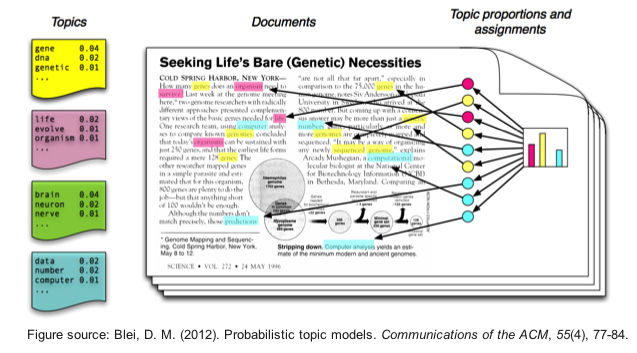
Example: Parlamentary debates¶
- Which topics are exihibited? → mixture of words in topics
- Who talks when about which topics? → mixture of topics in "documents" (i.e. debates)
Classic approach:
- use meta-data when provided
- TOPs in German Bundestag debates data not really usable – range from very specific ("Bundeswehreinsatz in Südsudan") to very general ("Fragestunde")
- use human judgment
- extremely time-consuming (~15,000 speeches; avg. ~400 words each)
- sampling → easy to miss important documents/topics
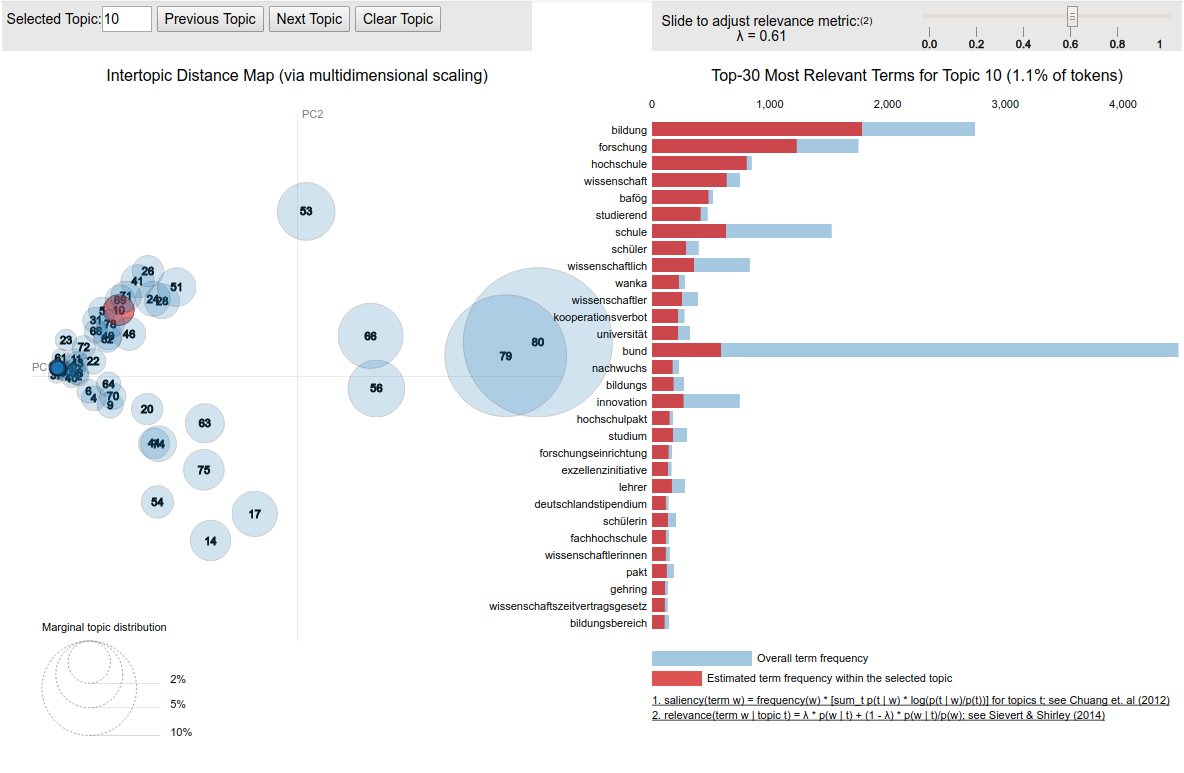

Why should I need that?¶
Corpus exploration¶
- topic modeling originally invented for browsing large corpora
- exploration / filtering by selecting topic(s) → show documents related to topic(s)
- can be combined with visualization tools
Data analysis¶
- topic proportions per document
- topic shift over time
- clustering of documents
- networks of topics (topic co-occurrence, Wiedemann 2015)
Has been used successfully for hypothesis testing (Fligstein et al 2017)
Assumptions¶
- **order of words in documents does not matter** → "bag of words" model
- no relations between words → no context! → topics are "neutral" (**but:** context of words within topics can be interpreted)
- documents can by anything: news articles, scientific papers, books, chapters of books, paragraphs
- but: each document should convey a *mixture of topics* → problematic with very short documents (tweets)
- **order of documents in a corpus does not matter**
- **the number of topics $K$ is known (has to be set in advance)**
- infer from the data by evalating the quality of a model (not today's topic)
Prerequisites¶
- input text must be preprocessed:
- tokenize: split sentence into separte "tokens" (~ words)
- normalize: stemming, lemmatization (find word stems)
- filter: remove stopwords, punctuation, etc.
Original: "In the first World Cup game, he **sat** only on the bank."
Tokens: first, world, cup, game, he, sit, bank
- exact preprocessing steps (stopword removal, n-grams) domain specific!
Input: document-term-matrix (DTM)¶
- tokens are converted to document term matrix (DTM) (according to "bag of words" model)
- maps documents to word frequencies
| document | russia | putin | soccer | bank |
|---|---|---|---|---|
| $D_1$ | 3 | 1 | 0 | 1 |
| $D_2$ | 0 | 0 | 2 | 1 |
| $D_3$ | 0 | 0 | 0 | 2 |
The LDA topic model¶
An LDA topic model can be described by two distributions:
- a document-topic distribution $\theta$: each document has a distribution over a fixed number of topics $K$
- a topic-word distribution $\phi$: each topic has a distribution over a fixed vocabulary of $N$ words
Given this model, we can generate words:
- for each document $d$ in a corpus $D$, generate each word $w$ like this:
- draw a topic $t$ from a document-specific distribution over topics $\theta_d$
- draw a word $w$ from a topic-specific distribution over words $\phi_t$
Topic-word distribution $\phi$¶
Each topic has a distribution over all words in the corpus:
| topic | russia | putin | soccer | bank | possible interpretation |
|---|---|---|---|---|---|
| topic 1 | 0.5 | 0.4 | 0.0 | 0.1 | russian politics |
| topic 2 | 0.1 | 0.0 | 0.7 | 0.2 | soccer in russia |
| topic 3 | 0.3 | 0.0 | 0.0 | 0.7 | russian economy |
- $K$ (num. of topics) distributions across $W$ words
- topics are a mixture of words → have different weights on words
- different meanings of words can be interpreted (soccer: "player sat on the bank" / economy: "banks in crisis")
2. document-topic distribution $\theta$¶
→ describes the documents (which topics are important for them)

Document-topic distribution $\theta$¶
Each document has a different distribution over all topics:
| document | topic 1 | topic 2 | topic 3 | possible interpretation |
|---|---|---|---|---|
| doc. 1 | 0.0 | 0.3 | 0.7 | mostly about soccer and russian economy |
| doc. 2 | 0.9 | 0.0 | 0.1 | russian politics and a bit of economy |
| doc. 3 | 0.3 | 0.5 | 0.2 | all three topics |
- $D$ (num. of documents) distributions across $K$ topics
- documents are a mixture of topics, each to a different proportion
Estimating $\phi$ and $\theta$¶
direct calculation not possible (involves $K^n$ terms with $n$ being num. tokens in corpus) (Griffiths & Steyvers 2004)
estimations either with:
- Expectation-Maximization algorithm – an optimization algorithm (Blei, Ng, Jordan 2003)
- Gibbs sampling algorithm – a "random walk" algorithm (Griffiths & Steyvers 2004)
both are rather complicated algorithms
LDA with Gibbs sampling¶
- $K$ .. num. topics
- $D$ .. documents
- $Z$ .. assigns a word $w$ in a document $d$ to a topic $t \in [1, K]$
Algorithm uses iterative resampling
First: initialize a random $Z$ – each word is randomly assigned to a topic
LDA with Gibbs sampling¶
- repeat for many iterations*:
- for each document $d$ in $D$ and each word $w$ in $d$:
- calculate sampling probability $p(z*)$ for drawing new topic for $w$
- depends on current topic assignments of all other words ($Z_{\lnot\{d,w\}}$)
- $p(z*) = p(w|z) p(z|d)$
- $p(w|z)$: how likely is $w$ for each topic assignment $z$
- $p(z|d)$: how likely is each topic assignment $z$ for $d$
- sample a new topic assignment $z*$ from $p(z*)$, set $Z_{d,w} = z*$
- calculate sampling probability $p(z*)$ for drawing new topic for $w$
Finally determine $\phi$ and $\theta$ from current $Z$.
* depends on corpus size (~1000 iterations is usually fine – log-likelihood must converge)
LDA with Gibbs sampling¶
supplementary tm_toy_lda notebook shows step-by-step implementation
Important take-aways:¶
- Gibbs sampling is a random process
- converges after some iterations (can be assessed with log-likelihood)
- each time you run the algorithm, the results will slightly differ*
- topic numbers will be completely different → they do not say anything!*
- hyperparameters need to be set in advance:
- number of topics $K$
- concentration parameters $\alpha$ and $\beta$
* unless your random number generator is manually set to a certain state and your data and hyperparameters are the same
Concentration parameters $\alpha$ and $\beta$¶
- $\alpha$ and $\beta$ specify prior beliefs about sparsity of topics ($\alpha$) and words ($\beta$)
- both parameters are concentration parameters for *Dirichlet* distributions used as priors
- $\alpha$ defines Dirichlet priors of $\theta$
- $\beta$ defines Dirichlet priors of $\phi$
- both are usually *symmetric*, i.e. a scalar value putting equal weight on words and topics respectively
- *asymmetric* priors: weight on certain words/topics
- [Wallach et al. (NIPS 2009)](http://papers.nips.cc/paper/3854-rethinking-lda-why-priors-matter) show that asymmetric priors on $\phi$ are not recommendable, but can be favorable on $\theta$
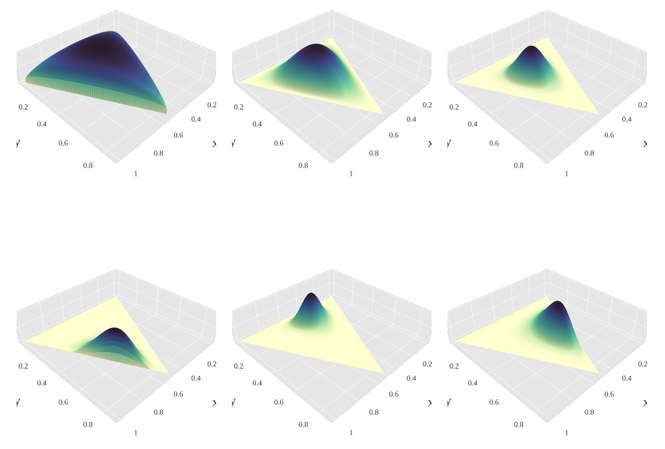 Dirichlet distributions with concentration paramaters in clock-wise order: (1.3,1.3,1.3), (3,3,3), (7,7,7), (2,6,11), (14,9,5), (6,2,6) – [source](https://en.wikipedia.org/wiki/File:Dirichlet-3d-panel.png)
Dirichlet distributions with concentration paramaters in clock-wise order: (1.3,1.3,1.3), (3,3,3), (7,7,7), (2,6,11), (14,9,5), (6,2,6) – [source](https://en.wikipedia.org/wiki/File:Dirichlet-3d-panel.png)
Concentration parameters $\alpha$ and $\beta$ in practice¶
$\alpha$ as prior belief on sparsity of topics in the documents:
- when using **high $\alpha$**: each document covers many topics (lower impact of topic sparsity)
- when using **low $\alpha$**: each document covers only few topics (higher impact of topic sparsity)
- $\alpha$ is often set to a fraction of the number of topics $K$, e.g. $\alpha=1/K$ → with increasing $K$, we expect that each document covers fewer, but more specific topics
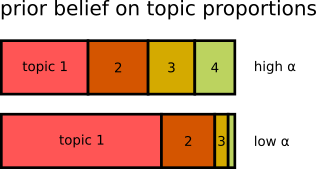
$\beta$ as prior belief on sparsity of words in the topics
- when using **high $\beta$**: each topic consists of many words (lower impact of word sparsity) → more general topics
- when using **low $\beta$**: each topic consists of few words (higher impact of word sparsity) → more specific topics
- $\beta$ can be used to control "granularity" of a topic model
- high $\beta$: fewer topics, more general
- low $\beta$: more topics, more specific
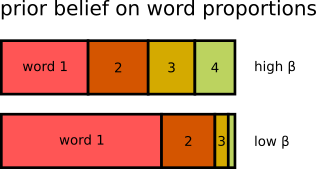
Impact of $\beta$¶
 high $\beta$ – good number of topics between 100 and 200
high $\beta$ – good number of topics between 100 and 200
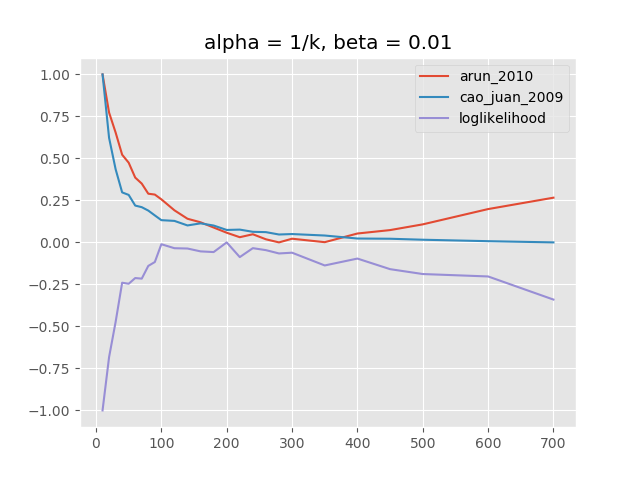 low $\beta$ – good number of topics between 200 and 400
low $\beta$ – good number of topics between 200 and 400
Note: x-axis is number of topics, y-axis is normalized scale for different "model quality" metrics
Practice – Using LDA for Topic Modeling¶
Software¶
- Python packages:
- lda – fast Gibbs sampling implementation
- implementations using Expectation-Maximization / Variational Bayes:
- LDA in scikit-learn
- Gensim – can work with corpora bigger than computer's memory (but is slower)
- other software:
- MALLET – academic standard written in Java, contains many state of the art algorithms but is rather slow and memory-intensive
- Stanford Topic Modeling Toolbox – features user interface; outdated
- R topicmodels package – fast Gibbs sampling implementation for R
- R text2vec package
Considerations before using LDA / common pitfalls¶
Problem: Your data does not meet the assumptions for LDA, e.g.:
- documents are too short (e.g. tweets, chat messages): no mixture of topics
- corpus consists of few but very long documents (e.g. a collection of Tolstoy novels): too few information shared across documents
- corpus consists of documents of very different lengths (e.g. collection of tweets and Tolstoy novels): big documents dominate topics; both of the above problems
- order of documents does matter (e.g. ordered by time)
Solutions:
- merge documents where possible (e.g. combine all tweets of a user per week)
- split documents where possible (e.g. split novels by chapters/paragraphs/etc.)
- use alternative algorithm (Gibbs sampling vs. Variational Bayes approach)
- use other approach than (classic) LDA
Problem: You do not know which priors to set (num. topics $K$, $\alpha$, $\beta$)
- evaluate models with different hyperparameter sets using model quality metrics (covered in a later session)
- use automatic hyperparameter optimization for $\alpha$, $\beta$ like in MALLET
- use a non-parametric alternative to classic LDA
Problem: A lot of uninformative words appear in my topics
- use stopword lists to remove very common words from the corpus
Problem: Some topics are very general and uninformative
- LDA tends to create some very general topics with most common words
- as long as it is only a few topics: ignore them in further analysis
- otherwise improve stopword list and adjust hyperparameters
Problem: Computing the models takes very long
- calculate several models in parallel on a multi-processor machine (e.g. WZB's theia machine)
Problem: Out of memory errors (corpus is too big for memory)
- make sure to use sparse matrices as data structures
- use software like Gensim that can stream data from hard disk
Alternatives to classic LDA for Topic Modeling¶
Latent Semantic Analysis (LSA) and Non-negative Matrix Factorization (NMF)¶
- can be helpful when the assumptions for LDA are not met
- input does not have to be integer data (e.g. tf-idf transformed data can be used)
- do not require hyperparameters (i.e. no prior beliefs must (or can!) be specified)
- output is usually not as easy to interpret as the posterior distributions obtained from LDA
Extensions to LDA¶
- dynamic topic models (Blei & Lafferty 2006) – topic shift over time
- hierarchical topic models (Blei, Griffiths, Jordan 2010) – tree of topics
Literature¶
Introductionary¶
- Introduction to Probabilistic Topic Models (Blei 2011)
- Topic modeling made just simple enough (Underwood 2012)
- Text Analytics with Python (Sarkar 2016), p.234-249
